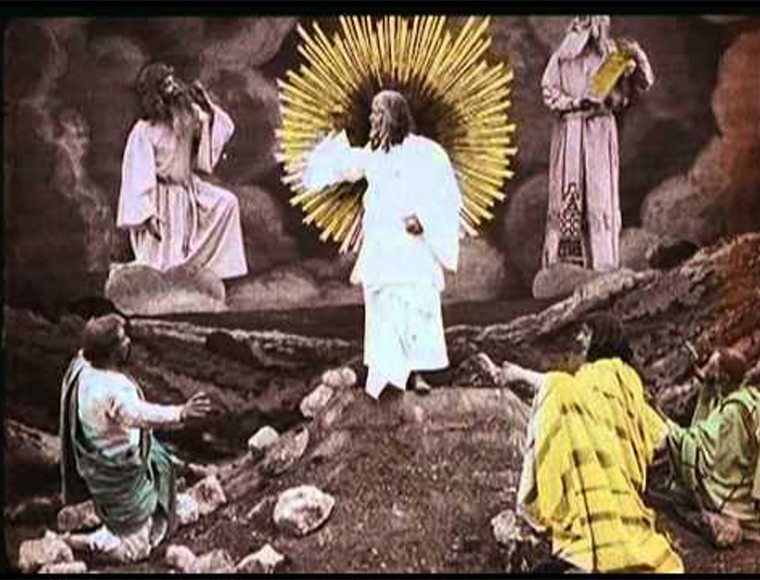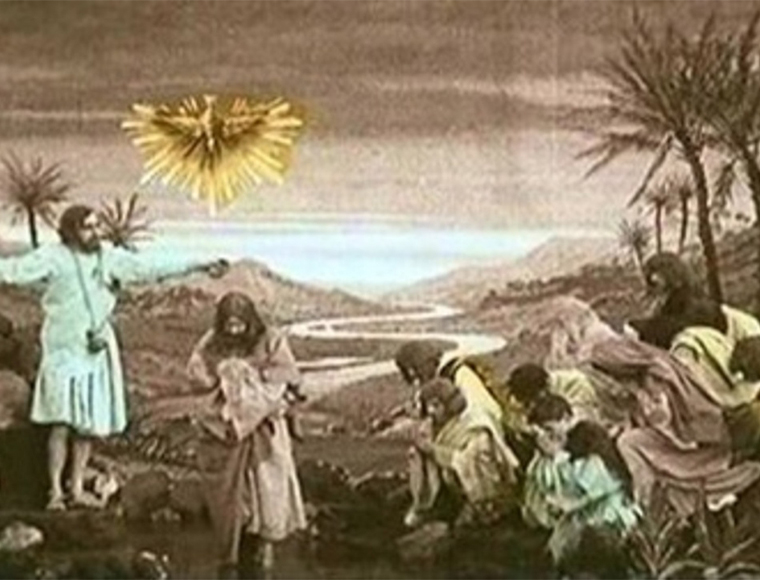(Editor’s note: Films about Jesus, either documentaries or features, are a staple of the Lenten season. WAG’s Phil Hall, who just brought the magazine two more Connecticut Press Club Awards for his feature articles, has recently completed his 10th book, “Jesus Christ Movie Star,” which will be published on May 3 by BearManor Media. It’s a protean subject to which Phil brings his usual thoroughness, smooth writing style and attention to quirky detail. In this excerpt, Phil discusses a 1903 French film version of the Gospels that took some interesting liberties with the sacred text: )
In the early years of the 20th century, the motion picture industry was plagued with incessant bootlegging of films. Shady characters who passed themselves off as producers and distributors would obtain copies of films and claim them as their own property, selling prints to unsuspecting exhibitors that were unaware of the original source material. This was particularly problematic with European filmmakers who did not have a U.S. sales presence and, thus, could not defend their property outside of their continent.
Legal enforcement of cinematic intellectual property was still in its infancy at that time, so the threat of litigation was not the best strategy. The French company Pathé Frères came up with an odd yet effective solution when it was preparing the release of its 1903 production “La Vie et la Passion de Jésus Christ”: The company’s logo was a rooster, and everyone involved in the film industry was aware of that symbol. Even audiences recognized the poultry logo. But rather than limiting the rooster logo to the opening credits, Pathé Frères made it part of the Biblical epic.
In watching “La Vie et la Passion de Jésus Christ” today, it is difficult not to fall into the habit of playing “spot the rooster” as the symbolic fowl was stenciled on the walls and stairwells of many of the film’s scenes. It is also on the side of the Disciples’ boat when they view Jesus walking on water. Strangely, it is absent from the scene of Peter denying Jesus after the rooster crows three times.
None of the characters in the film called attention to the presence of a rooster stencil that shadowed Jesus as He traveled across the Holy Land, and one can assume that most of the audiences in 1903 weren’t wondering about why an illustrated rooster kept turning up in ancient Judea. However, the ubiquity of this symbol helped to keep “La Vie et la Passion de Jésus Christ” from being bootlegged endlessly – and for a number of years, other filmmakers borrowed this trick of sticking logos into the scenes.
But what about the film that Pathé Frères was trying to protect? “La Vie et la Passion de Jésus Christ” was an unusual production for its time. Back when most films were only one-reel in length and produced on modest budgets, “La Vie et la Passion de Jésus Christ spanned a rather epic 44 minutes and was presented with a large cast and extravagant production design, including an extensive hand-stenciling of scenes to achieve color cinematography effects.
“La Vie et la Passion de Jésus Christ” breaks the story of Jesus into vignettes that are introduced by title cards heralding the event to be depicted. There are no intertitle dialogue breaks – which is understandable, as the story would have been extremely familiar to most audiences at the time and intertitles would have disrupted the pageant depictions.
“La Vie et la Passion de Jésus Christ” incorporates special effects throughout its presentation, starting with the Annunciation and the appearance of an angel standing on a cloud and followed by the appearance of the Star of Bethlehem above the shepherds. The double exposure style of the camera trickery calls to mind the charming cinematic magic of Georges Méliès, albeit with a more pronounced seriousness instead of Méliès’ feats of happy tomfoolery.
The film finds Mary and Joseph walking into Bethlehem in search of a place to stay. Later New Testament films would have the pregnant Mary riding a donkey rather than traveling on foot. There is an unintentionally funny scene when the Wise Men and the shepherds crowd into the already-cramped manger to view the newborn Jesus. The presence of so many people in a tiny space recalls the classic stateroom scene from the Marx Brothers’ “A Night at the Opera,” albeit without the slapstick blackout gag.
The film also oomphs up the story by adding a group of musically gifted angels to play for the infant Jesus as He rests in His crib. When Mary and Joseph flee into Egypt, the audience knows where they are because the Holy Family rests with the Sphinx and the pyramids behind them.
Obviously, the entire life of Jesus could not be telescoped into the 44-minute running time, so Jesus’ adult life is truncated. The grownup Jesus encounters John the Baptist and then turns water into wine at Cana before Mary Magdalene shows up to clean His feet. A visually impressive (although somewhat eccentric) depiction of Jesus walking on water finds Him ascending from the depths of a churning sea and walking casually with outstretched arms while the waves crash around him. A brief consideration of the Transfiguration is depicted with Jesus conversing casually with Moses and Elijah.
Nearly all of “La Vie et la Passion de Jésus Christ” is shot with a static camera positioned far from the actors, as if a stage play is being recorded. There are two brief cutaway scenes – Jesus accepting his Pilate-dictated fate with the words “Ecce Homo” on a wall behind him and the apocryphal Veronica holding up the cloth that captured Jesus’ image after she wiped his face during his trek to Golgotha. (The presence of Veronica and the cloth with Jesus’ image is not part of the canonical Gospels, but with this film it became a staple of Jesus-centric cinema for years to come.)
“La vie et la passion de Jésus Christ” also offers a whimsical consideration of the Resurrection, with angels carefully lifting the tomb and Jesus’ ghostly spirit rising up and floating around, frightening away the centurions guarding His resting place. In the Ascension, Jesus rides a circular cloud into Heaven, where he sits next to God (a white-haired man with a flowing white beard) and begins to converse with the same casual nature that defined the film’s depiction of the Transfiguration.
The direction of “La Vie et la Passion de Jésus Christ” is credited to Ferdinand Zecca and Lucien Nonguet. There is no record of the actors in the cast. The performer in the role of Jesus appears to be a bit on the hefty side, a considerable difference from the more svelte actors that would play this role later on. Most of the film was shot on painted sets, with only a few exterior shots, notably the rocky tomb that held Lazarus.
“La Vie et la Passion de Jésus Christ” was an extremely popular film on both sides of the Atlantic and, remarkably, it was still enjoying theatrical playdates as late as 1932, well into the sound-film era.


